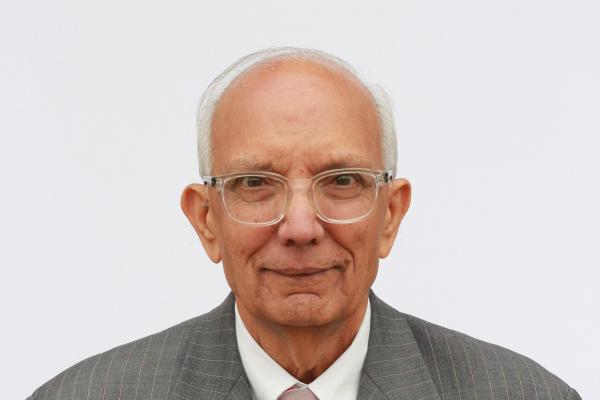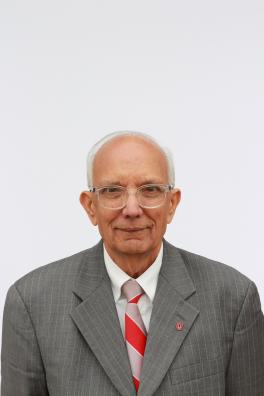
Soil as Source and Sink of Greenhouse Gases
Professor Rattan Lal
CFAES Rattan Lal Center for Carbon Management and Sequestration (Ohio State)
Location: 1080 Physics Research Building, Smith Seminar Room
Faculty Host: Nandini Trivedi

Abstract: World soils are the largest reservoir of carbon in the terrestrial biosphere. Soils store two types of carbon : soil organic carbon(SOC) and soil inorganic carbon(SIC). Estimated to 1-m depth, soils of the world contain 1550 Pg of SOC and an additional 750( to 950 ) Pg SIC. Thus , the total soil C stock in world soils of ~2300 Pg is 3.7 times that in all vegetation( 560 Pg in the living biomass and 60 Pg in the detritus material ) and 2.6 times that in the atmosphere( 880 Pg ) which is increasing at the rate of about 5.3 Pg C/yr. The SIC stock is more in soils of the arid and semi arid regions and that of the SOC in soils of humid and sub-humid regions.There are two types of SIC in soil: primary carbonates derived from the weathering of parents rocks and also called lithogenic carbonates, and the secondary carbonates also called the pedogenic carbonates derived from the pedological processes. The formation of secondary carbonates in soil is an important process of sequestration of atmospheric CO2.Similarly,formation of new humus or soil organic matter from decomposition of the fresh biomass produced by plants within a land unit also leads to sequestration of atmospheric CO2.
Being a major source of plant nutrients( N,P,S,Ca,Mg,K and micronutrients) , SOC has been exploited for its nutrient reserves ever since the dawn of settled agriculture about 10 millennia ago.Conversion of natural to agricultural ecosystems,by deforestation and burning of biomass along with drainage of land and its plowing , accelerates the process of decomposition of SOC. Mineralization of SOC and its lateral transport over the landscape is also accelerated by accelerated soil erosion by water ( hydric erosion) and wind (aeolian erosion).Thus, most agricultural soils are depleted of their original C stocks. The magnitude of loss of SOC stocks is estimated at about 130 Pg C. Total loss of C from land use conversion since the beginning of agriculture ( from vegetation and soil ) may be about 600 Pg . In comparison the loss of C from fossil fuel combustion since circa 1750 is about 460 Pg.
Thus, re-carbonization of world soils and vegetation , by choice of a restorative land use and adoption of management practices which create a positive soil C budget, is an important option for adaptation to and mitigation of the anthropogenic climate change.Finding a non-carbon fuel source as a substitute of fossil fuel and re-carbonization of the soil and vegetation are important strategies to keep global warming to below 2 C. Soil carbon sequestration has many co-benefits. It is a win-win option ,and a bridge to the future until no-carbon fuel sources take effect.
More about the speaker:
Rattan Lal, Ph.D., is a Distinguished University Professor of Soil Science and is the founding Director of the CFAES Rattan Lal Center for Carbon Management and Sequestration at The Ohio State University. He received B.Sc. from Punjab Agricultural University, Ludhiana, India (1963); M.Sc. from Indian Agricultural Research Institute, New Delhi, India (1965); and Ph.D. from the Ohio State University, Columbus, Ohio (1968). He was Sr. Research Fellow at University of Sydney, Australia (1968-69), Soil Physicist at International Institute of Tropical Agriculture, Ibadan, Nigeria (1970-87), and Professor of Soil Science at Ohio State University (1987 to date). He has authored/co-authored over 1000 refereed journal articles and more than 550 book chapters, and has written and edited/co-edited more than 100 books. He received an Honoris Causa degree from nine universities throughout Europe, USA, South America, and Asia; the Medal of Honor from UIMP, Santander, Spain (2018); the Distinguished Service Medal of the International Union of Soil Sciences (2018); and is fellow of the five professional societies. Dr. Lal has mentored 115 graduate students and 182 visiting scholars from around the world. He was President of the World Association of Soil and Water Conservation (1987-1990), International Soil and Tillage Research Organization (1988-1991), Soil Science Society of America (2006-2008), and the International Union of Soil Sciences (2017-2018). He holds the Chair in Soil Science and is the Goodwill Ambassador for Sustainability Issues for the Inter- American Institute for Cooperation on Agriculture (IICA), and member of the 2021 United Nations Food Security Summit Science Committee and Action Tracks 1 & 3. Dr. Lal is laureate of the GCHERA World Agriculture Prize (2018), Glinka World Soil Prize (2018), Japan Prize (2019), U.S. Awasthi IFFCO Prize (2019), Arrell Global Food Innovation Award (2020), World Food Prize (2020), India’s Padma Shri Award (2021).He is an honorary member of the Moldova Academy of Sciences (2022) , and a member of the Academia Europaea(2022).He received the Presidential Award of the Soil Science Society of America(2022), and the IPCC-Nobel Peace Prize Certificate in 2007.The Punjab Agricultural University, Ludhiana, named its Soil Science and Agronomy building as Rattan Lal Laboratories in 2020.
The colloquium can also be seen on Zoom: Watch on Zoom
